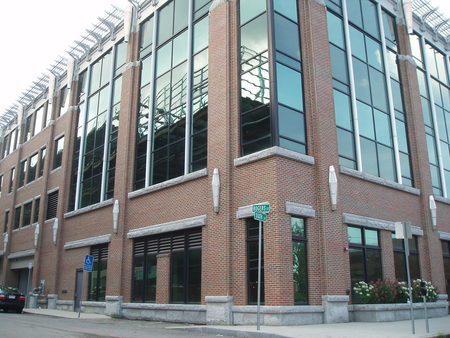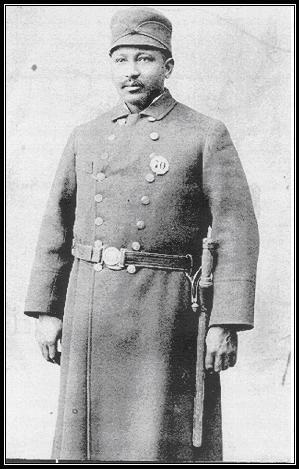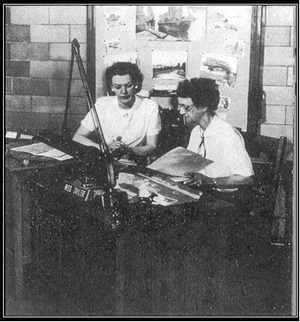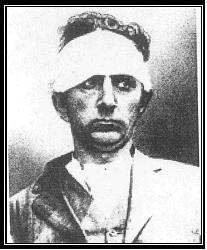The building received a Silver LEED Certification from the U.S. Green Building Council, and a plaque representing this accomplishment is now prominently displayed in the lobby of the building at 125 6th Street.
Department History

The Cambridge Police Department is currently in the process of researching some of its own history. As we continue to learn about how our department has grown over the years, we will feature a new story every few weeks in this section. Eventually, this page will contain various types of information. Until then, please enjoy some of the stories we have selected.
As of December 2008, the Cambridge Police Department relocated from the station at 5 Western Ave to the new, state-of-the-art Robert W. Healy Public Safety Facility located at 125 Sixth Street.
The building received a Silver LEED Certification from the U.S. Green Building Council, and a plaque representing this accomplishment is now prominently displayed in the lobby of the building at 125 6th Street.
LEED Certification

First Black Police Officer & Sergeant

Frederick Arthur Robinson, one of four children, was born in August 1852 in Annapolis, Nova Scotia to Richard T. Robinson and Isabella Gordon, both of English descent. The Robinson family moved from Nova Scotia to Cambridge in 1870 when Frederick was about 18 years old.
He was appointed to the Cambridge Police Force in April 1884, when Mayor Fox nominated him to become the first black police officer for Cambridge. He worked a beat that included Western Ave, Putnam Ave, Dana St, Broadway, and Inman to Main Sts. Prior to becoming a police officer he worked as a laborer and a teamster. In 1904 the Police Force was reorganized and Mayor Daly promoted Officer Robinson to the rank of Sergeant. In a Cambridge Chronicle newspaper article dated April 30, 1904 it stated that; “As a patrolman Mr. Robinson has done good services, and he is promoted solely on his merits. He knows the duties of a patrolman, and will make a good sergeant.” He worked at Station 2 until his illness early in the summer of 1914, and retired later in 1914 with a pension after 30 years of service.
Sergeant Robinson passed away on December 4, 1914 at age 62 in his home on 15 Union Street, Cambridge, MA. He is buried in Cambridge Cemetery. As stated in the December 17, 1914 issue of the Cambridge Chronicle: “He was considered an ideal patrolman and superior officer, and his knowledge of police matters ranked him with the leaders.”
First Female Cambridge Police Officer

Edith J. Taylor spent 33 years as a Cambridge Police Officer. Hired as an investigator in July of 1919, she became a full-time policewoman in March of 1921.
She is remembered as a woman who enjoyed helping Cambridge youth stay on the right path. She was a key player in helping to establish a Big Brother/Big Sister program in the city. She felt that it would be better to have an older “sibling” looking after a young person rather than a police officer. Officer Taylor felt that because of the freedom of the times and the speed of modern living, the children of the era were a bit harder to control than those of 30 years ago (to put this in perspective, 30 years ago to her was before 1900). She believed that parents of teen-age children should know where they are at night, whom they are with and that they should set curfews.
Ms. Taylor was involved in other duties as well. A story she liked to tell was about how she used to patrol Harvard Square establishments asking women to put out their cigarettes.
She was eventually succeeded in the department by Mrs. Louise Nelson Darling as the second female police officer.
Infamous Cambridge Criminal

On April 6, 1906, Leone (Krembs) Munter gave birth to her second daughter. Although she was healthy and there were no complications during the birth, ten days later she was dead. Her husband, Erich Munter, a professor of German at Harvard University, immediately called an undertaker wishing to have his wife cremated. When it appeared to the undertaker that the woman had been dead for several hours, he informed Mr. Munter that he would have to call the Medical Examiner. Some preliminary tests were taken, sent to Harvard Medical College for analysis, and the body released. Mr. Munter then chose to take Leone’s body to Chicago, where her family lived, to be buried there. He left Leone’s body and their two small daughters with her parents and disappeared. Subsequent analysis showed large amounts of arsenic in Leone’s system.
Nine years later, on July 2, 1915 at 11:40 PM thunder rolled from the Capital Dome in Washington, DC, as a bomb exploded in the Senate Reception Room. The room was destroyed, but luckily no one was injured as it was late evening and the Senate would not convene again until December of that year. The next morning the Washington newspapers received a letter from “R. Pierce” calming responsibility for the explosion stating it was a protest against America’s unfair trafficking in ammunition for European allies in the fight against the Kaiser.
Mr. Lester was arrested and identified himself as “Mr. Frank Holt,” a professor of German at Cornell University in New York. In addition, Mr. Holt confessed to bombing the capital and sending the letter. He also stated that he placed a second bomb on a ship that left New York a few days prior, and that it was set to explode on July 7th. During questioning, Mr. Holt insisted that he was born in the United States, although he had a profound German accent. In addition, he had what was described as a “shambling walk;” the same description previously used for Munter, alerting the suspicion of the authorities. A photo of Frank Holt (see above) was brought to Erich Munter’s sister, who immediately identified the man in the photo as being that of her brother Erich. Fearing that the authorities were “on to him” for his wife’s murder, Erich Munster escaped from his jail cell and jumped, head first, from the top of the cell door onto a concrete floor, splitting his skull and killing himself.
On July 7, 1915 there was an explosion aboard the S.S. Minnehaha, which had left from New York and was carrying a large amount of ammunition. Fortunately, the bomb was placed on the promenade deck, far from the ammunition, and the S.S. Minnehaha suffered only a small fire.
J. P. Morgan, Jr. survived and lived to a ripe old age. It is believed that Munter killed Leone because he did not want a second daughter. Leone’s family raised their two daughters, changing their sir name to Krembs. Munter, under the name Frank Holt married a second time and had a son. His second wife buried him in Dallas, TX…the name on his headstone is Frank Holt. In a strange twist of fate, a fellow Cornell University colleague later admitted that he had recognized Munter and knew that he was using the name Holt as an alias, but had not told anyone.
Send Us Your Cambridge Police History!
Do you have old photographs with Cambridge Police Officers in them? A story about a relative who was a CPD Officer? Other interesting historical information?
If so, send us an e-mail and let us know what you have. We may feature it in this section!

